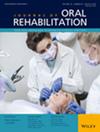Sleep-Disordered Breathing in Early Adolescent Orthodontic Patients: Prevalence and Correlation With Dentofacial Morphological Features
Abstract
Objective
The objectives were to (1) assess the frequency of adolescents potentially at risk for sleep-disordered breathing (SDB) as measured by the paediatric sleep questionnaire (PSQ), and (2) investigate any associations between adolescents at risk for SDB and specific dentofacial characteristics extracted from standard orthodontic records.
Methods
Patients aged 6–16 years, receiving orthodontic treatment, were included. All patients had completed the Danish version of PSQ. Based on the PSQ score, the sample was divided into two groups: high-risk and low-risk of SDB. Features related to clinical examination, dental cast analysis and cephalometric assessment were tested for intergroup differences between the high-risk and the low-risk PSQ groups. Student's t-tests, Chi-square test and linear mixed models were computed to compare the dentofacial variables of the two groups.
Results
A total of 246 patients were included (94 boys and 152 girls, mean age 12.7 ± 2.1). The prevalence of patients with a PSQ score indicating a high risk of SDB was 6.5% (n = 16). The mean values of A-N-Pog, A-N-B and S-N-A were significantly larger in the high-risk group compared to the low-risk group by 1.5° (p = 0.037), 1.3° (p = 0.043) and 2.0° (p = 0.050) respectively. When considering the results from a linear mixed model, A-N-Pog and A-N-B showed statistically significant differences between the two groups.
Conclusions
Six percent of patients presented a high risk of SDB. The present study showed that adolescents at a high risk for SDB displayed more sagittal skeletal discrepancies compared to those at low risk. This study's strength lies in its large and representative sample of orthodontic patients, enabling comprehensive analysis of SDB-related factors, yet the small number of high-risk SDB cases detected constitutes a statistical limitation, highlighting the need for further research with an even larger sample.


 求助内容:
求助内容: 应助结果提醒方式:
应助结果提醒方式:


